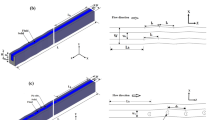Abstract
Arrays of surface ribs have been reported to significantly enhance particle collection efficiency in particle removal devices. However, the surface ribs also cause a higher pressure drop. Therefore, the overall performance needs to take into consideration the above factors. In this study, different forms of surface ribs inspired by nature were designed and parametric studies were performed to enhance deposition efficiency. Our parametric studies comprised three different aspects: geometry of the patterned surface, pitch-to-height ratio, and particle size. The flow field around patterned surfaces was simulated in a two-dimensional channel flow by using the Reynolds stress model, corrected by turbulence velocity fluctuation in the wall-normal direction. The particle trajectory was solved by using Lagrangian particle tracking. When the overall efficiency ratio was considered, a semi-circular pattern had the best overall efficiency with 1137 times increase when compared to the case without patterns. Although the open-circular pattern has the minimum particle deposition enhancement, the overall efficiency of the open-circular pattern has 862 times increase compared to the case without patterns. Surface ribs (semi-circular, triangular and rectangular) can achieve a higher particle deposition velocity, but a higher flow resistance is generated compared with applying the open-circular surface ribs. The deposition location was then investigated for different surface ribs at different pitch-to-height ratios (p/e). This study shows that the semi-circular surface pattern should be recommended to enhance the overall performance of particle removal devices, especially for submicron particles.
Similar content being viewed by others
Abbreviations
- A :
-
cross-section area of the duct
- C c :
-
Cunningham correlation
- C D :
-
particle drag coefficient
- C μ :
-
empirical constant specified in the turbulent model
- d :
-
partice size
- D h :
-
hydraulic diameter
- f :
-
friction factor
- F :
-
component of particle forces
- h :
-
channel height
- J :
-
particle flux
- k :
-
turbulence kinetic energy
- N d :
-
number of deposited particles
- N 0 :
-
initial particle numbers
- n 0 :
-
particle number per volume
- p :
-
pressure
- pe :
-
duct perimeter
- Re :
-
Reynolds number
- S :
-
particle to air density ratio
- t :
-
deposition duration
- u :
-
air velocity
- u* :
-
friction velocity
- u d :
-
particle deposition velocity
- u p :
-
local velocity of particle
- U mean :
-
mean velocity
- U free :
-
freestream velocity
- y :
-
vertical position of the channel
- α :
-
contact angle
- η :
-
efficiency index
- v :
-
kinematic viscosity of air
- μ :
-
dynamic viscosity of air
- ρ :
-
density of air
- τ :
-
particle relaxation time
- τ w :
-
wall shear stress
- i, j :
-
vector and/or tensor indices
- + :
-
nondimensionalization
- g:
-
gas phase
- p:
-
particle phase
References
Bechert DW, Bruse M, Hage W (2000). Experiments with three-dimensional riblets as an idealized model of shark skin. Experiments in Fluids, 28: 403–412.
Bechert D, Bruse M, Hage W, Meyer R (1997). Biological surfaces and their technological application—Laboratory and flight experiments on drag reduction and separation control. In: Proceedings of the 28th Fluid Dynamics Conference, Snowmass Village, CO, USA.
Beckett KP, Freer-Smith PH, Taylor G (1998). Urban woodlands: their role in reducing the effects of particulate pollution. Environmental Pollution, 99: 347–360.
Bhushan B (2009). Biomimetics: Lessons from nature—An overview. Philosophical Transactions of the Royal Society A: Mathematical, Physical and Engineering Sciences, 367: 1445–1486.
Bhushan B, Her EK (2010). Fabrication of superhydrophobic surfaces with high and low adhesion inspired from rose petal. Langmuir, 26: 8207–8217.
Dean B, Bhushan B (2010). Shark-skin surfaces for fluid-drag reduction in turbulent flow: A review. Philosophical Transactions of the Royal Society A: Mathematical, Physical and Engineering Sciences, 368: 4775–4806.
Deyuan Z, Yuehao L, Huawei C (2011). Application and numerical simulation research on biomimetic drag-reducing technology for gas pipelining. Oil Gas European Magazine, 37(2): 85–90.
Fu SC, Leung WT, Chao CYH (2014). Detachment of droplets in a fully developed turbulent channel flow. Aerosol Science and Technology, 48: 916–923.
Ji JH, Bae GN, Kang SH, Hwang J (2003). Effect of particle loading on the collection performance of an electret cabin air filter for submicron aerosols. Journal of Aerosol Science, 34: 1493–1504.
Liu M, Wang S, Wei Z, Song Y, Jiang L (2009). Bioinspired design of a superoleophobic and low adhesive water/solid interface. Advanced Materials, 21: 665–669.
Lu H, Lu L (2015). Effects of rib spacing and height on particle deposition in ribbed duct air flows. Building and Environment, 92: 317–327.
Nosonovsky M, Bhushan B (2008). Multiscale Dissipative Mechanisms and Hierarchical Surfaces. Berlin: Springe.
Saffman PG (1965). The lift on a small sphere in a slow shear flow. Journal of Fluid Mechanics, 22: 385–400.
Suh YJ, Kim SS (1996). Effect of obstructions on the particle collection efficiency in a two-stage electrostatic precipitator. Journal of Aerosol Science, 27: 61–74.
Tian L, Ahmadi G (2007). Particle deposition in turbulent duct flows—comparisons of different model predictions. Journal of Aerosol Science, 38: 377–397.
Xu H, Fu SC, Leung WT, Lai TW, Chao CYH (2020). Enhancement of submicron particle deposition on a semi-circular surface in turbulent flow. Indoor and Built Environment, 29: 101–116.
Zhao B, Chen C, Lai ACK (2011). Lagrangian stochastic particle tracking: further discussion. Aerosol Science and Technology, 45: 901–902.
Acknowledgements
This project was supported by a Collaborative Research Fund (CRF) project (No. C7025-16G) and HKSAR General Research Fund (GRF) project (No. 16207817, No. 16206918).
Author information
Authors and Affiliations
Corresponding author
Rights and permissions
About this article
Cite this article
Xu, H., Fu, S.C., Chan, K.C. et al. Bio-inspired patterned surface for submicron particle deposition in a fully developed turbulent duct. Build. Simul. 13, 1111–1123 (2020). https://doi.org/10.1007/s12273-020-0681-7
Received:
Revised:
Accepted:
Published:
Issue Date:
DOI: https://doi.org/10.1007/s12273-020-0681-7




